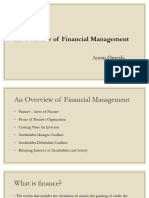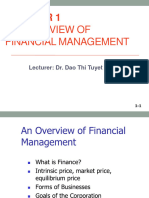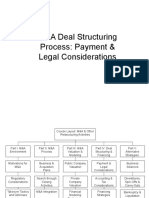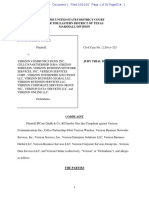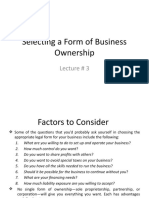Finance, Focuses On Decisions Relating To How Much and
Uploaded by
Meng DanFinance, Focuses On Decisions Relating To How Much and
Uploaded by
Meng DanChapter 1: Overview of Financial Management People who work in finance need knowledge of both
economics and accounting.
Finance - the system that includes the circulation of
money, the granting of credit, the making of Four main forms of business organizations:
investments, and the provision of banking facilities. 1. Proprietorships - is an unincorporated business
owned by one individual.
AREAS OF FINANCE: Advantages:
1. Financial management - also called corporate 1. they are easy and inexpensive to form;
finance, focuses on decisions relating to how much and 2. they are subject to few government
what types of assets to acquire, how to raise the capital regulations; and
needed to purchase assets, and how to run the firm so 3. they are subject to lower income taxes than
as to maximize its value. are corporations.
2. Capital markets - relate to the markets where Disadvantage:
interest rates, along with stock and bond prices, are 1. unlimited personal liability
determined. 2. the life of the business is limited to the life
- Also studied here are the financial of the individual who created it.
institutions that supply capital to 3. proprietorships have difficulty obtaining
businesses. Banks, investment banks, large sums of capital
stockbrokers, mutual funds, insurance
companies, and the like bring together 2. Partnerships - is a legal arrangement between two or
“savers” who have money to invest and more people who decide to do business together.
businesses, individuals, and other Advantage:
entities that need capital for various a. can be established easily and inexpensively
purposes. b. does not have corporate income tax because
3. Investments - relate to decisions concerning stocks the firm’s income is allocated on a pro rata basis
and bonds and include a number of activities: to the partners and is taxed on an individual
a. Security analysis deals with finding the proper basis
values of individual securities (i.e., stocks and Disadvantage:
bonds). a. all of the partners are generally subject to
b. Portfolio theory deals with the best way to unlimited personal liability
structure portfolios, or “baskets,” of stocks and b. difficult for partnerships to raise large amounts
bonds. Rational investors want to hold of capital
diversified portfolios in order to limit risks, so
choosing a properly balanced portfolio is an 3. Corporations - is a legal entity created by a state, and
important issue for any investor. it is separate and distinct from its owners and
c. Market analysis deals with the issue of whether managers.
stock and bond markets at any given time are Advantage:
“too high,” “too low,” or “about right.” a. Limited liability
Included in market analysis b. Unlimited lives
is behavioral finance, where investor c. Unlimited capital
psychology is examined in an effort to Disadvantage:
determine whether stock prices have a. Double taxation
been bid up to unreasonable heights in
a speculative bubble or driven down to 4. limited liability companies (LLCs) and limited liability
unreasonable lows in a fit of irrational partnerships (LLPs) - LLC is a popular type of
pessimism. organization that is a hybrid between a partnership and
a corporation while, LLP similar to an LLC. LLPs are used
FINANCE VERSUS ECONOMICS AND ACCOUNTING for professional firms in the fields of accounting, law,
Finance, as we know it today, grew out of economics and architecture, while LLCs are used by other
and accounting. Economists developed the notion that businesses.
Advantage & Disadvantage:
an asset’s value is based on the future cash flows the
limited liability protection, but they are taxed as
asset will provide, and accountants provided
partnerships
information regarding the likely size of those cash flows.
the investors in an LLC or LLP have votes in Intrinsic value is a long-run concept. Management’s
proportion to their ownership interest goal should be to take actions designed to maximize
LLCs/LLPs were dreamed up by lawyers; they the firm’s intrinsic value, not its current market
are often structured in very complicated ways, price. Note, though, that maximizing the intrinsic
and their legal protections often vary by state. So, value will maximize the average price over the long
it is necessary to hire a good lawyer when run, but not necessarily the current price at each
establishing one. point in time.
Stockholder–Manager Conflicts
The Main Financial Goal: Creating Value for Investors It has long been recognized that managers’ personal
Company’s stockholders are not just an abstract goals may compete with shareholder wealth
group—they represent individuals and organizations maximization. In particular, managers might be more
who have chosen to invest their hard-earned cash into interested in maximizing their own wealth than their
the company and who are looking for a return on their stockholders’ wealth; therefore, managers might pay
investment in order to meet their long-term financial themselves excessive salaries.
goals, which might be saving for retirement, a new Effective executive compensation plans motivate
home, or a child’s education. managers to act in their stockholders’ best interests.
Useful motivational tools include
1. reasonable compensation packages,
2. firing of managers who don’t perform well, and
3. the threat of hostile takeovers.
Compensation packages
Compensation packages should be sufficient to
attract and retain able managers, but they should not
go beyond what is needed.
Compensation should be structured so that
managers are rewarded on the basis of the stock’s
performance over the long run, not the stock’s price on
an option exercise date.
*TERMS:
Intrinsic value -
an estimate of a stock’s “true” value based on accurate risk and retu Direct Stockholder Intervension
rn data. The intrinsic value can be estimated, but not measured preci Majority of stock is owned by institutional
sely investors such as insurance companies, pension funds,
Market price - the stock value based on perceived but possibly
incorrect information as seen by the marginal investor hedge funds, and mutual funds; and private equity
Marginal investor - an investor whose views determine the actual groups are ready and able to step in and take over
stock price underperforming firms. These institutional money
Equilibrium - the situation in which the actual market price equals managers have the clout to exercise considerable
the intrinsic value, so investors are indifferent between buying and
influence over firms’ operations.
selling a stock
Intrinsic value Managers’ Response
Estimating intrinsic values is what security analysis is If a firm’s stock is undervalued, corporate
all about and is what distinguishes successful from raiders will see it as a bargain and will attempt to
unsuccessful investors. capture the firm in a hostile takeover. If the raid is
Investing would be easy, profitable, and essentially successful, the target’s executives will almost certainly
riskless if we knew all stocks’ intrinsic values; but, of be fired. This situation gives managers a strong
course, we don’t. We can estimate intrinsic values, incentive to take actions to maximize their stock’s price.
but we can’t be sure that we are right. In the words of one executive, “If you want to keep your
A firm’s managers have the best information about job, never let your stock become a bargain.”
the firm’s future prospects, so managers’ estimates Corporate Raiders - Individuals who target
of intrinsic values are generally better than those of corporations for takeover because they are
outside investors. However, even managers can be undervalued.
wrong. Hostile Takeover - The acquisition of a company
over the opposition of its management.
Managers should try to maximize their stock’s intrinsic
value and then communicate effectively with
stockholders. That will cause the intrinsic value to be
high and the actual stock price to remain close to the
intrinsic value over time.
Stockholder–Debtholder Conflicts
Debtholders, which include the company’s
bankers and its bondholders, generally receive fixed
payments regardless of how well the company does,
while stockholders do better when the company does
better. This situation leads to conflicts between these
two groups, to the extent that stockholders are typically
more willing to take on risky projects.
Balancing Shareholder Interests and The Interests of
Society
Shareholder Wealth Maximization - The primary
financial goal for managers of publicly owned
companies implies that decisions should be made to
maximize the long-run value of the firm’s common
stock.
* Managers have an obligation to behave ethically, and
they must follow the laws on corporate governance that
we discussed in the opening vignette to this chapter.
Business Ethics
As a result of the financial scandals occurring during the
past decade, there has been a strong push to
improve business ethics.
Sarbanes–Oxley Act of 2002 to impose
sanctions on executives who sign financial
statements later found to be false
Dodd–Frank Act to implement an aggressive
overhaul of the U.S. financial regulatory system
aimed at preventing reckless actions that would
cause another financial crisis
Ethics is defined in Webster’s Dictionary as “standards
of conduct or moral behavior.”
Business ethics can be thought of as a company’s
attitude and conduct toward its employees, customers,
community, and stockholders.
What Companies Are Doing
Most firms today have strong written codes of
ethical behavior; companies also conduct training
programs to ensure that employees understand proper
behavior in different situations. When conflicts arise
involving profits and ethics, ethical considerations
sometimes are so obviously important that they
dominate.
You might also like
- Accounting Principles Volume 1 Canadian 7th Edition Geygandt Solutions ManualNo ratings yetAccounting Principles Volume 1 Canadian 7th Edition Geygandt Solutions Manual92 pages
- Jack Guttman Vs Warren Diamond John Delmonaco, Jacob FrydmanNo ratings yetJack Guttman Vs Warren Diamond John Delmonaco, Jacob Frydman129 pages
- Introduction-to-finanace-09122024-014803pmNo ratings yetIntroduction-to-finanace-09122024-014803pm31 pages
- Fidelia Agatha - 2106715765 - Summary & Problem MK - Pertemuan Ke-1No ratings yetFidelia Agatha - 2106715765 - Summary & Problem MK - Pertemuan Ke-122 pages
- Material No. 1 An Overview of Financial Management: Expected Learning OutcomesNo ratings yetMaterial No. 1 An Overview of Financial Management: Expected Learning Outcomes6 pages
- Financial Management: Finance and Financial Markets: Chapter 1No ratings yetFinancial Management: Finance and Financial Markets: Chapter 128 pages
- Chapter1An Overview of Financial ManagementNo ratings yetChapter1An Overview of Financial Management47 pages
- Chapter 1: An Overview of Financial ManagementNo ratings yetChapter 1: An Overview of Financial Management5 pages
- Chapter 1 - An Overview of Financial ManagementNo ratings yetChapter 1 - An Overview of Financial Management30 pages
- An Overview of Financial Management - Chapter 1No ratings yetAn Overview of Financial Management - Chapter 137 pages
- Topic 01 Introduction To Financial ManagementNo ratings yetTopic 01 Introduction To Financial Management37 pages
- Financial Management 2 - Chapter 1 and 2 SummaryNo ratings yetFinancial Management 2 - Chapter 1 and 2 Summary2 pages
- Introduction To Managerial Finance Chapter 1No ratings yetIntroduction To Managerial Finance Chapter 120 pages
- Chapter1 Introduction To Business Finance PresentationNo ratings yetChapter1 Introduction To Business Finance Presentation11 pages
- Answers in Assignment: Relevant Costing/Differential AnalysisNo ratings yetAnswers in Assignment: Relevant Costing/Differential Analysis2 pages
- Answers in Assignment: Introduction To Mas: Name: Dañas, Maria Mengee D. (2018003501) Section: 5No ratings yetAnswers in Assignment: Introduction To Mas: Name: Dañas, Maria Mengee D. (2018003501) Section: 51 page
- Answers in Assignment: Absorption & Variable Costing: Problem 1: A. $1,400 B. $7,400No ratings yetAnswers in Assignment: Absorption & Variable Costing: Problem 1: A. $1,400 B. $7,4002 pages
- Underwriter Facilitates The Issuance of Securities. The: Physical Asset MarketsNo ratings yetUnderwriter Facilitates The Issuance of Securities. The: Physical Asset Markets5 pages
- Exercises Absorption and Variable CostingPAUL ANTHONY DE JESUSNo ratings yetExercises Absorption and Variable CostingPAUL ANTHONY DE JESUS4 pages
- Annual Report: Chapter 3: Financial Statements, Cashflow, and Taxes Financial Statements and ReportsNo ratings yetAnnual Report: Chapter 3: Financial Statements, Cashflow, and Taxes Financial Statements and Reports2 pages
- FIN 105 - I. An Overview of Financial Management PDFNo ratings yetFIN 105 - I. An Overview of Financial Management PDF9 pages
- Blue and White Project Proposal - PresentationNo ratings yetBlue and White Project Proposal - Presentation18 pages
- Managing Engineering and Technology: Sixth Edition Morse and BabcockNo ratings yetManaging Engineering and Technology: Sixth Edition Morse and Babcock22 pages
- 11 Chapter 11 Payment Legal ConsiderationsNo ratings yet11 Chapter 11 Payment Legal Considerations17 pages
- FORM 10-K: United States Securities and Exchange CommissionNo ratings yetFORM 10-K: United States Securities and Exchange Commission55 pages
- Appendix B Google Complaint For Replevin (Verizon)No ratings yetAppendix B Google Complaint For Replevin (Verizon)7 pages
- The Truth About Ebix, Robin Raina, and The Robin Raina Foundation100% (1)The Truth About Ebix, Robin Raina, and The Robin Raina Foundation46 pages
- DIRECTION: Read The Statement Carefully and Choose The Answer That Best Described The Statement. Write Your Answer in Your Answer SheetNo ratings yetDIRECTION: Read The Statement Carefully and Choose The Answer That Best Described The Statement. Write Your Answer in Your Answer Sheet3 pages
- Business Basics for Law Students 4th Edition Robert W. Hamilton all chapter instant download100% (1)Business Basics for Law Students 4th Edition Robert W. Hamilton all chapter instant download51 pages





